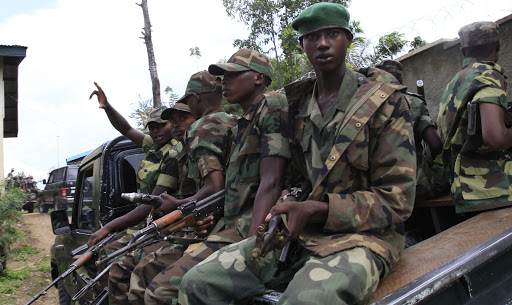On 18 October 1996, the Alliance of Democratic Forces for the Liberation of Congo-Zaire (AFDL) was officially formed. The AFDL was a loose coalition of rebels led by Laurent-Desiré Kabila and backed by Rwandan and Ugandan forces. It launched an armed campaign from the DRC’s east to oust President Mobutu. The AFDL is well known to have targeted refugee camps along the Zaire-Rwanda border, killing hundreds of thousands of Hutu civilians.
AFDL Creation
From the second half of 1995, the Rwandan authorities, in cooperation with those in Kampala, began their preparations to facilitate a mass military intervention of the Zairian territory by the APR and UPDF, under the guise of a domestic rebellion. To enable the rebellion to surface, Rwandan and Ugandan leaders requested the help of Tutsis in Zaire who had served in the FRP and APR for several years to mass recruit in North Kivu and South Kivu to start a Banyamulenge rebellion. They also made contact with the leaders of small Zairian rebel groups that had been foes of President Mobutu for decades (André Kisase Ngandu’s CNRD (Conseil national de résistance pour la démocratie) and Laurent-Désiré Kabila’s PRP (Parti de la Révolution Populaire)) to give the rebellion a national dimension.

The killing of Hutu Refugees
On 18 October 1996, AFDL launched an armed campaign from the DRC’s east. Under the cover of the AFDL, whose own troops, weapons and logistics were supplied by Rwanda, soldiers from the APR, the UPDF (Uganda People’s Defence Force) and the FAB (Forces armées burundaises) entered Zaire en masse and set about capturing the provinces of North and South Kivu and the Ituri district.
The AFDL initially targeted refugee camps along the Zaire-Rwanda border that housed thousands of Hutu civilians. During this lightning offensive, units of the AFDL, APR and FAB attacked and destroyed all the Rwandan and Burundian Hutu refugee camps set up around the towns of Uvira, Bukavu and Goma. Tens of thousands of refugees were killed in these camp attacks. Several hundreds of thousands of Rwandan refugees returned to Rwanda, but hundreds of thousands of others, fled towards the territories of Walikale (North Kivu) and Shabunda (South Kivu). For several months, they were pursued by AFDL and APR soldiers, who went about systematically destroying the makeshift refugee camps and persecuting anyone who came to their aid.
The United Nations, Amnesty International and many other governmental and non-governmental observers have reported large-scale massacres of refugees in eastern DRC perpetrated by members of the AFDL and their allies APR and FAB since the beginning of the armed conflict in October 1996. It is believed that hundreds of thousands of unarmed refugees have been killed in the forests of eastern DRC.
Aid workers said to have been used by AFDL soldiers on many occasions to locate refugees in order to kill them. This has been especially typical of massacres in South-Kivu. These refugees, who have fled attacks by the AFDL on camps in South-Kivu since October 1996, have been living in the forests in this remote area of eastern DRC and attending feeding centres set up by aid workers.
While Kabila, due to his international contacts and ability to speak multiple languages, was clearly the AFDL spokesperson, there was some question about who was the ultimate leader. André Kisase Ngandu, an elder insurgent with revolutionary credentials, was the president of the AFDL’s military wing, the National Resistance Council (CNRD), and apparently expressed opposition to the massacre of Hutu refugees in Congolese camps. This internal tension between the two men was resolved on 4 January 1997, when Ngandu was assassinated in North Kivu by Rwandan Tutsi soldiers, allegedly at the instigation of Kabila and/or Rwandan President Paul Kagame. Kabila thereafter appointed himself president of the CNRD as well as retaining his position as spokesperson and head of the political wing.
Once the Kivus were captured, the remainder of the First Congo War consisted for the most part of the AFDL and its allies pursuing and killing Hutu refugees and driving across Zaire to the capital, Kinshasa.
On 16 May 1997, after seven months of rebellion and the failure of peace talks, Mobutu fled the country. The AFDL marched into Kinshasa a day later. Kabila declared himself president and renamed the country to the Democratic Republic of the Congo (DRC). The AFDL then became the new national armed forces.
Mapping Report > Section I. Most serious violations > CHAPTER II. First Congo War > B. Attacks against Hutu refugees > 1. South Kivu > Uvira territory: Attacks against Hutu refugees – Uvira territory (South Kivu)
